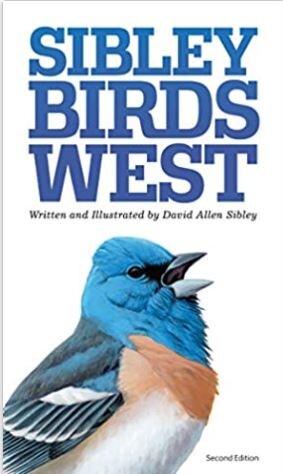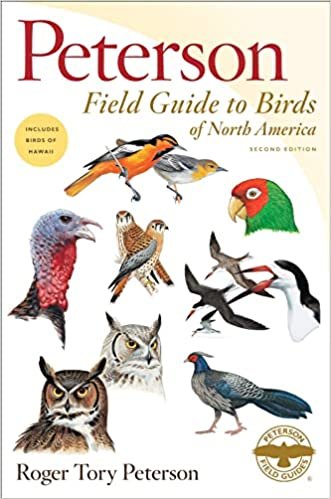References Guides and Resources
Birding Guides
The following birding guides are frequently used by Sacramento Audubon Society members. Find them at your local bookstore, or order online.
150 Frequently Seen Birds of California’s Great Valley by American River Natural History Association (ARNHA) Books
A pocket birding field guide just for California's Great Valley! This beautiful, 300+ page book features full color images and detailed descriptions of the many bird species found in the valley. Small enough to fit in a pocket or waist pack, yet loaded with helpful information, this book is sure to become a hit among California's nature-lovers and beginning birders alike!
The Sibley Guide to Birds, Second Edition
The publication of The Sibley Guide to Birds, First Edition quickly established David Allen Sibley as the author and illustrator of the nation’s supreme and most comprehensive guide to birds. Used by millions of birders from novices to the most expert, The Sibley Guide became the standard by which natural history guides are measured. This second edition builds on this foundation of excellence, offering massively expanded and updated information, new paintings, new and rare species, and a new, elegant design.
Sibley Birds West: Field Guide to Birds of Western North America, Second Edition
Compact and comprehensive, this guide features 715 bird species, plus regional populations, found west of the Rocky Mountains. Entries include accurate illustrations--more than 5,046 in total--with descriptive captions pointing out the important field marks.
National Geographic Field Guide to the Birds of the United States and Canada—West, 2nd Edition
Birdwatchers from the Rockies west will find nearly 1,000 species in this user-friendly guide, with all new text, updated art, and data-driven maps. Backyard beginners and dedicated life-listers alike will love the expanded new edition of this trusted guide to the birds of western United States and Canada, including Hawaii. With new text, revised art, and data–derived range maps, this valuable resource complements the apps and online resources used by birders today.
National Geographic Field Guide to the Birds of the United States and Canada, 8th edition
America’s beloved bird field guide just got even better with this completely revised 8th edition, created for a new generation of birders. This new edition of the trusted National Geographic field guide combines fresh new text, updated taxonomy, expanded art including 240 new illustrations, and authoritative, data-derived maps, organized in the user-friendly format for which our field guides are known.
Kaufman Field Guide to Birds of North America
Critically acclaimed for its innovative design, the Kaufman guide introduced a new generation to birding. The Kaufman Field Guide to Birds of North America includes the official names of birds and range maps. Additional information helps beginning birdwatchers get started, all in the same compact format that has made this guide the easiest to use for fast identification in the field.
Peterson Field Guide to Birds of North America, Second Edition
For decades, the Peterson Field Guide to Birds has been a popular and trusted guide for birders of all levels, thanks to its famous system of identification and unparalleled illustrations. Since the American Birding Association has expanded its species Checklist to include Hawai’i, the Peterson Field Guide now includes the wonderful and exotic species of our fiftieth state. In addition, the text and range maps have been updated, and much of the art has been touched up to reflect current knowledge.
Birds of the Sierra Nevada: Their Natural History, Status, and Distribution by Ted Beedy and Ed Pandolfino
This beautifully illustrated and user-friendly book presents information about the natural histories of birds of the Sierra Nevada, the origins of their names, the habitats they prefer, how they communicate and interact with one another, their relative abundance, and where they occur within the region. Each species account features original illustrations by Keith Hansen.
Hansen’s Field Guide to the Birds of the Sierra Nevada by Keith Hansen, Edward C. Beedy, Adam Donkin
Identify and learn about over two hundred and fifty birds of the Sierra Nevada. From tiniest hummingbirds to condors with nine-foot wingspans; from lower-elevation wrens to the rasping nutcrackers of the High Sierra; from urban House Sparrows to wild water–loving American Dippers, Hansen’s Field Guide to the Birds of the Sierra Nevada showcases artist-naturalist Keith Hansen’s sixteen-year project to illustrate the birds of the Sierra Nevada. This book is the field guide companion to the Birds of the Sierra Nevada: Their Natural History, Status, and Distribution.
Life Under the Fast Lane: Ecology and Conservation of Bridge-Nesting Purple Martins in Urban Sacramento by Daniel A. Airola
Life Under the Fast Lane reports on 20 years of study and conservation efforts for the unique population of Western Purple Martins that nests in bridges in urban Sacramento. The Purple Martin, a state Species of Special Concern, has declined throughout California. The Central Valley’s last population has persisted in Sacramento but is rapidly declining.
The book presents detailed information on the species’ history in the region, its ecology and current population status, and the dramatic recent decline due to pesticide and land use conflicts. It describes management actions and presents land use planning practices needed to avoid impacts from ever-present urban development projects.
Sidebar discussions describe behind-the-scenes stories about conducting martin research in an urban setting and address questions that are often posed about the population. The book will be interesting and useful to those concerned about conserving Sacramento’s Purple Martins, including environmentalists, birders, conservation biologists, land-use planners, and decision-makers.
Sacramento County Breeding Birds: A Tale of Two Atlases and Three Decades of Change by Edward R. Pandolfino, Lily A. Douglas, Timothy D. Manolis, and Chris Conard
Sacramento County Breeding Birds examines how nearly three decades of dramatic transformation of much of this county have affected our local breeding birds. The book puts the changes in breeding bird status and distribution in the context of conservation efforts and changes in land use, climate, and regulatory protection. The text focuses on the most significant changes and a complete set of paired maps shows the changes in breeding distribution for every species.
But don’t assume that this is a story of gloom and doom. While some breeding birds have declined, and others disappeared altogether from the county, even more new breeders have arrived. And some species have demonstrated remarkable adaptability and resilience by colonizing urban habitats.
Online Bird Guides
Audubon Guide to North American Birds The Audubon Bird Guide is a free and complete field guide to over 800 species of North American birds. Built for all experience levels, on your phone it will help you identify the birds around you, keep track of the birds you’ve seen, and get outside to find new birds near you.
All About Birds From The Cornell of Ornithology, this is a free resource that will help you identify birds, learn about their life history, and much more.
Xeno-Canto is a free website dedicated to sharing wildlife sounds, including bird sounds, from all over the world. Whether you are a research scientist, a birder, or simply curious about a sound that you heard out your kitchen window, we invite you to listen and explore the bird sound recordings in the collection.
Birds of the World Take a deep dive into the remarkable lives of birds with this dynamic natural history resource from The Cornell Lab of Ornithology. A subscription is required.
Citizen Science Apps
Did you know counting birds can help science? There are numerous citizen science programs that birders can participate in. Find ideas below of local, national, and worldwide programs.
eBird
Join eBird, an online database project created by the Cornell Laboratory of Ornithology and the National Audubon Society. eBird allows people to report real-time bird sightings and observations.
Merlin Bird ID
Free instant bird identification help for more than 6,000 species of birds. Merlin is designed to be a birding coach for beginning and intermediate bird watchers.
NestWatch
NestWatch is a continent-wide project to monitor bird nests. The project was started by the Cornell Laboratory of Ornithology and the Smithsonian Migratory Bird Center.
Celebrate Urban Birds
Observe birds in an urban neighborhood for the Celebrate Urban Birds project, and send the data to scientists at the Cornell Laboratory of Ornithology.
Project Feeder Watch
Help Project FeederWatch with a winter-long survey of birds that visit feeders at backyards, nature centers, community areas, and other locations in North America.
iNaturalist
Photograph birds, plants, animals, and other organisms. Use the iNaturalist app or iNaturalist.org to upload your observations and add them to a global database of biodiversity to support local to global research projects.
Resources for Creating Bird Friendly Gardens
Native Gardening creates habitats that support a wide variety of birds. Adapted to local environmental conditions, native plants require less water, are pest resistant and generally low maintenance. Below are helpful links for gardening with native plants.
Calscape.org helps you select the right native plants for your location. The California Native Plant Society partnered with the UC Berkeley Jepson Herbarium to create this native plant database that helps you discover the plants best suited to your property.
UC Davis Arboretum Watch this site for native plant sales and native plant information. Check out their Climate-Ready Gardening Toolkit for articles on Valley-wise gardening.
UC Davis Bee Haven is the UC Davis School of Entomology’s pollinator-friendly garden and is open daily from dawn until dusk. If you can’t visit in person, check out their Bee Gardening Resources.
UC Berkeley Urban Bee Lab is a good resource to find the best plants for bees and other pollinators.
Wild Birds Unlimited in Sacramento is a wonderful resource for bird food, feeders, houses, and other items that can help make your backyard a destination for local birds.
Nest Boxes
Nest boxes are wonderful additions to your bird-friendly garden. With patience and a little luck your nest box could house one of several species native to the Sacramento region such as: Tree Swallow, Oak Titmouse, White-breasted Nuthatch, Bewick’s Wren, Northern House Wren, Ash-Throated Flycatcher, Western Bluebirds, American Barn Owl, and Western Screech-Owl. Or you could provide a safe haven for a flying mammal by installing a bat box.
Visit the following links to learn more:
All About Birdhouses: Right Bird, Right House
From the Cornell Lab of Ornithology, this NestWatch tool will help you determine which birds you can build a nest box or nest structure for in your region or habitat.California Bluebird Recovery Program
Provides information and training on how to install and maintain appropriate nest boxes for bluebirds and other cavity nesters. Watch their January 2022 presentation to the Sacramento Audubon Society on Successful Backyard Nestboxes.How to Build a Screech-Owl Nest Box
From the National Audubon Society, this article has step-by-step instructions for building a home that Western Screech-Owls will hopefully find accommodating.Bat Houses From Bat Conservation International, here you will find information on building or buying Bat Houses as well as information on how beneficial bats are to the local and global ecosystem.

















